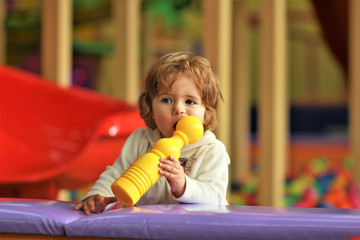My Child is Constantly Putting Things in His Mouth
by Tracie Dahl, OTR/L
Kids Place Central Pediatric Occupational Therapist
You may have heard your child’s therapist talk about proprioception and the importance of providing proprioceptive input, but what is it?
The proprioceptive system helps tell us about the movement and position of our joints and muscles. It helps us control how strongly and in what way we move. For example, our proprioceptive system helps us know to be careful when picking up something delicate like a cup of water compared to using all our strength and power to pick up a heavy suitcase. In our mouth, proprioceptive input is provided to the jaw when we chew and bite.
Signs your child may be looking for more proprioceptive input in their mouth include:
- Chewing on sleeves or the neck of a shirt
- Placing toys in their mouth even when you thought they should be “grown out of it”
- Chewing on the end of a pencil
- Loving very crunchy and chewy foods (an appropriate input)
By providing your child with appropriate proprioceptive input you may be able to decrease some of these less desirable behaviors. Activities you can do at home to provide proprioceptive input to the mouth include:
- Have your child drink thick liquids (e.g. smoothies, milkshakes) or liquid foods (e.g. applesauce, yogurt) through a small straw
- Blow bubbles – try a traditional bubble wand or try blowing on a straw placed in soapy water to create bubbles
- Use silly straws when drinking so the child has to suck longer to get the liquid
- Encourage foods that are crunchy and chewy such as carrots, apples, granola bars, dried fruit, beef jerky, pretzel rods or other foods appropriate for their age
- Play with mouth instruments such a kazoo, recorder, or harmonica
- Drink from a water bottle that has a bite valve such as the Camelback brand
- Provide vibration with an electric toothbrush or vibrating teether
If your child continues to display these “seeking” behaviors such as chewing and biting, or conversely seems to avoid different textures and sensations in their mouth, it may be beneficial to discuss these concerns with an occupational or speech therapist.







